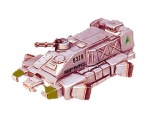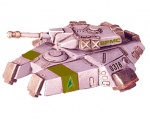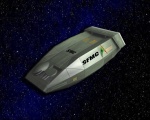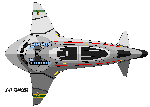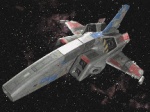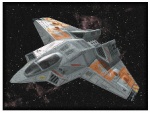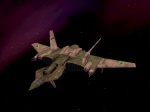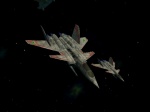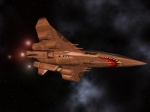SFMC Vehicles
Home |
Star Fleet Library |
BuPers |
SF Engineering |
SF Intelligence |
SF JAG |
SF Marine Corps |
SF Medical |
SF Records |
SF Sciences
UFP Dept. of Colonial Affairs |
UFP Educational, Scientific and Cultural Org.
Introduction
Below are some of the vehicles used by the SFMC. These are undergoing constant development, so be sure to check back on occasion for the latest in advanced Marine weaponry.
Ground Vehicles
Light Armored Vehicle
Armoured personnel transports, equipped with Type IV-A pulse phaser cannon, antigrav propulsion, operational ceiling of ~100m
Main Battle Tank
Type V phaser cannon armed or micro-torp armed self-propelled armored artillery, antigrav propulsion, operational ceiling of ~100m
Heavy Battle Tank
Muliple launchers for micro-torp armed self-propelled armored artillery, antigrav propulsion, operational ceiling of ~75m.
Air-Space Vehicles
DS-2412A Hammer Dropship
The Model 2412-A is a lifting body design with small winglets. The dropship resembles few things more than a streamlined brick. It has limited atmospheric maneuverability without the use of anti-gravity units. Slow by the standards of most space-capable vessels, the Model 2412, as its predecessors, suvives by a combination of armor and stealth. Few craft of its size can match its sophisticated passive and active stealth capabliities unless they are equipped with an actual cloaking device.
The crew of six include a pilot, co-pilot, weapons operator, sensor operator, communications equipment operator, and an engineer.
The nose of the dropship is designed to be able to penetrate a ship's hull and seccure itself using graples which can be deployed after impact and force field projectors to seal the hull breech during ship-to-ship boarding operations.
The dropship is designed with ablative armor which allows it to absorb considerable energy weapon damage and to enter an atmosphere at very large incident angles without burning up on re-entry.
In ship to surface operations each Battle Suited Marine stands in a Mk II atmospheric ablative cocoon. These cocoons can be launched from the dropship at an altitude of up to 100 km for independant re-entry.
The surface armament includes a plasma cannons, an 80mm Gauss cannon, and 10mm Gauss Multi-barrels. These are mounted in three retractable turrets, one underneath the nose, aft of the boarding ram, and two above the aft wing roots.
Plasma Cannon, Mk X - The plasma cannon is a type of ion weapon. It operates by exciting the atoms of a gas to the point where they spontaneously ionize and expelling the plasma bolt in a magnetic bottle which breaks upon impact. A plasma cannon burns through ablative armor more effectively than a phaser weapon which tends to have its energy conducted across a wider surface area. Moreover, phaser weapons have the potential at higher power settings to trigger explosive decoupling of atomic bonds in matter. Plasma weapons do not operate in the same manner as phasers and so do not pose this risk.
10mm Gauss Multi-Barrel, Mk VI - The Mk VI Gauss Multi-Barrel is both a crew-served weapon and a vehicular weapon. The Mk VI has a higher velocity, higher rate-of-fire, and a more explosive warhead in its darts than the Mk V Gauss Rifle. While Star Fleet seldom uses projectile weapons, there are cases where they are more effective than either phasers or plasma weapons. Shaped charge projectiles are often the most effective way to deal with armored individuals. Virtually all modern projectile weapons use an electromagnetic linear accelerator to launch the projectile. In the common vernacular, these are referred to as "Gauss" rifles and pistols. Most Gauss weapons fire an explosive dart.
80mm Gauss Cannon, Mk XI - When indirect fire capabilities are needed, electromagnetic cannons are used as artillery or to replace the main armament on hover tanks. These weapons operate similarly to their smaller rifle and pistol counterparts, though they are never fitted with the relatively delicate sniper spin control mechanism for reasons of maintainability in battle conditions. These weapons fire a variety of types of shells. These can include conventional high explosive, armor piecing, anti-matter, concussion, sonic, and anesthesia gas rounds. In the case of anti-matter rounds, the Federation strictly limits the size of charges to limit collateral damage. The maximum charge deployed in the field is a 5 kiloton TNT equivalent charge containing 120 mg of antimatter. (Note: The bomb that destroyed Hiroshima had the energy equivalent of about 20 kilotons of TNT.) Most artillery shells fired carry a 12 mg charge, 500 ton TNT equivalent.
Battle suits are the most common type of powered armor. Larger powered armor suits have been phased out because, while they are capable of allowing the wearer to sustain heavier damage and carry heavier weapons, they severely limit maneuverability and stealth. Battle suits can be environmentally sealed to withstand gas attacks and even zero-atmosphere situations. These suits of powered armor increase the individual's strength by approximately a factor of 10. They may be variously configured for greater scouting capabilities, heavy weapons loads, and endurance. In scout mode, the suit is equipped with a standard type III phaser weapon, an advanced sensor system, a secure tight beam transmitter, and additional power packs. While scout equipped suits do not offer a substantial increase in firepower over a conventionally armored marine, they allows the marine to move at sustained speeds up to 60 kph and have approximately 50 hours of endurance with the suit sealed to atmosphere and using onboard life support. At the other extreme, a battle rigged suit might carry a type IV phaser on a stablized mount, a standard type II phaser for close range, a grenade launcher, and an advanced targetting system. These heavy weapons reduce the ability to carry additional power cells and have high power drain. As a result, a suit equipped as above, while having much more firepower than any single marine not in power armor, would only have about 4 hours of endurance even with the suit not powering its onboard life support systems. The armor will stop most conventional projectiles from portable armaments and offers some protection from crew-served projectile weapons. The ablative armor also offers protection against energy weapons. The mesh has the ability to conduct and disperse an energy weapon charge as well, helping to diffuse the effects of all but the highest power shorts from a phaser or disruptor. (Maximum power kill will still vaporize an armored fighter and heavy stun will still stun. Light stun is usually not effective except on a very lucky shot.)
The Model 2412-A was field tested aboard the USS NOVA and on the planet Borea in January 2412.
- Designation: DS-2412A
- Nick name: Hammer
- Type: Marine landing craft
- Dimensions:
- Length: 30m
- Beam: 16m
- Draft: 7m
- Crew: 6
- Capacity:
- Standard Combat Dress: 1 Company (150)
- Battle Suits: 3 Platoons (105)
- Ablative cocoons: 2 Platoons (70) Battle Suited
- Mixed (No cocoons):
- 1 Platoon (35) Battle Suited
- 3 Platoons (105) Standard
- With 1 APC:
- Standard Combat Dress: 2 Platoons (70)
- Battle Suits: 1 Platoon (35)
- With 1 Tank:
- Standard Combat Dress: 1 Platoon (35)
- Battle Suits: 2 Squads (20)
- Maximum Takeoff Weight: 2100 mt
- Sublight Speed:
- Maximum Range Cruise: 0.15c
- Shield Limit: 0.70c
- Acceleration: 175 km/sec^2
- Armament:
- Type V phaser
- Number: 4, 3 forward, 1 aft
- Range: 100,000 km
- Type Va pulse phaser
- Number: 2, 1 dorsal turret; 1 ventral hull turret
- Range: 75,000 km
- Mk V mini-Photon torpedo
- Number: 1, forward (20 reloads)
- Range: 500,000 km
- Mk XI 80mm Gauss cannon
- Number: 1, ventral retractable nose turret
- Range: 50 km
- Mk X plasma cannon
- Number: 3, ventral retractable nose turret; aft dorsal wing root turrets (P/S)
- Range: 5 km
- Mk VI 10mm Gauss multi-barrel
- Number: 4, 2 each; aft dorsal wing root turrets (P/S)
- Range: 5 km
- Type V phaser
- Shields:
- FC-5a
- Ablative Armor
- Atmospheric capabilities: Yes
- Planetary landing capabilities: Yes
- Emergency Transporter: None
- Landing Pod: Mk II Atmospheric ablative cocoon
Combat Shuttles
The oldest combat shuttle in the inventory is the F-4 Phantom. The F-15 two-man strike fighter is a more modern and capable shuttle. However, both are eclipsed by the gravitic drive second generation combat shuttles which were first deployed aboard USS Kronshtadt. These craft, the F-36, F-47, and A-117 are revolutionary craft with greatly enhanced performance envolopes.
F-39 Shikra Combat Shuttle
The production version of the new gravity drive combat shuttle replaces the limited production run F-36.
- Designation: F-39
- Nick name: Shikra
- Type: single pilot, space superiority fighter
- Dimensions: Length: 15.5m, Beam: 11.0m, Draft: 4.5m
- Maximum Takeoff Weight: 40 mt
- Speed:
- Maximum Range Cruise: 0.30c
- Shield Limit: 0.80c
- Acceleration: 600 km/sec^2
- Armament:
- Type Va pulse phaser
- Number: 2, forward
- Range: 75,000 km
- Mk V mini-Photon torpedo
- Number: 1, forward (4 reloads)
- Range: 500,000 km
- Type Va pulse phaser
- Shields: FC-4b
- Atmospheric capabilities: Yes
- Planetary landing capabilities: Yes
- Escape Pod: Mk IV POIS ejection capsule.
- Emergency Transporter: (one time use)
A-41 Caracara Combat Shuttle
The production version of the new gravity drive combat shuttle replaces the limited production run F-47 and A-117.
- Designation: A-41
- Nick name: Caracara
- Type: two-person strike fighter
- Dimensions: Length: 17.0m, Beam: 12.3m, Draft: 4.7m
- Maximum Takeoff Weight: 45 mt
- Speed:
- Maximum Range Cruise: 0.28c
- Shield Limit: 0.78c
- Acceleration: 590 km/sec^2
- Armament:
- Type V phaser
- Number: 1, forward
- Range: 100,000 km
- Type Va pulse phaser
- Number: 2, forward
- Range: 75,000 km
- Mk V mini-Photon torpedo
- Number: 1, forward (3 reloads)
- Range: 500,000 km
- Type V phaser
- Shields: FC-4b
- Atmospheric capabilities: Yes
- Planetary landing capabilities: Yes
- Escape Pod: Mk IV POIS ejection capsule.
- Emergency Transporter: (one time use)
F-4 Phantom Combat Shuttle
Once the most common high performance impulse speed strike fighter, the F-4 cruises at up to 0.73c for extended periods. The F-4 could carry two Type Va pulse phaser cannon and one type IV mini-photon torpedo tube (yield of 10% full sized photon torpedo).
- Designation: F-4
- Nick name: Phantom
- Type: single pilot, strike fighter
- Dimensions: Length: 15m, Beam: 7m, Draft: 4m
- Maximum Takeoff Weight: 35 mt
- Speed: Maximum Range Cruise: 0.2c
- Shield Limit: 0.73c
- Acceleration: 240 km/sec^2
- Armament:
- Type Va pulse phaser
- Number: 2, forward
- Range: 75,000 km
- Mk IV mini-Photon torpedo
- Number: 1, forward (2 reloads)
- Range: 500,000 km
- Type Va pulse phaser
- Shields: FC-3b
- Atmospheric capabilities: Yes
- Planetary landing capabilities: Yes
- Escape Pod: Mk II POIS ejection capsule.
- Emergency Transporter: (one time use)
F-15 Lightning Combat Shuttle
Intended to replace the aging F-4, the F-15 boasts better electronics and more armament options. It can carry two type V phasers and one type Va phasers as well as a Mk IV mini-photon torpedo (yield of 10% full sized photon torpedo).
- Designation: F-15
- Nick name: Lightning
- Type: two-person strike fighter
- Dimensions: Length: 18m, Beam: 8m, Draft: 4.5m
- Maximum Takeoff Weight: 40 mt
- Speed: Maximum Range Cruise: 0.25c
- Shield Limit: 0.75c
- Acceleration: 250 km/sec^2
- Armament:
- Type V phaser
- Number: 2, forward
- Range: 100,000 km
- Type Va pulse phaser
- Number: 1, forward
- Range: 75,000 km
- Mk IV mini-Photon torpedo
- Number: 1, forward (3 reloads)
- Range: 500,000 km
- Type V phaser
- Shields: FC-3c
- Atmospheric capabilities: Yes
- Planetary landing capabilities: Yes
- Escape Pod: Mk III POIS ejection capsule.
- Emergency Transporter: (one time use)
F-36 Spectre Combat Shuttle
The replacement for the Phantom fighter, the Spectre has a higher cruise and maximum flight speed and is better armed. The new sublight drive system gives the fighter 250% of the acceleration of older F-4.
- Designation: F-36
- Nick name: Spectre
- Type: single pilot, space superiority fighter
- Dimensions: Length: 16.6m, Beam: 8.7m, Draft: 4.6m
- Maximum Takeoff Weight: 40 mt
- Speed: Maximum Range Cruise: 0.30c
- Shield Limit: 0.80c
- Acceleration: 600 km/sec^2
- Armament:
- Type Va pulse phaser
- Number: 2, forward
- Range: 75,000 km
- Mk V mini-Photon torpedo
- Number: 1, forward (4 reloads)
- Range: 500,000 km
- Type Va pulse phaser
- Shields: FC-4b
- Atmospheric capabilities: Yes
- Planetary landing capabilities: Yes
- Escape Pod: Mk IV POIS ejection capsule.
- Emergency Transporter: (one time use)
FA-47 Firkin Combat Shuttle
The replacement for the Lightning strike fighter, the Firkin has a higher cruise and maximum flight speed and is better armed than its predecessor.
- Designation: FA-47
- Nick name: Firkin
- Type: two-person strike fighter
- Dimensions: Length: 17.4m, Beam: 9.4m, Draft: 4.7m
- Maximum Takeoff Weight: 45 mt
- Speed: Maximum Range Cruise: 0.28c
- Shield Limit: 0.78c
- Acceleration: 590 km/sec^2
- Armament:
- Type V phaser
- Number: 1, forward
- Range: 100,000 km
- Type Va pulse phaser
- Number: 2, forward
- Range: 75,000 km
- Mk V mini-Photon torpedo
- Number: 1, forward (3 reloads)
- Range: 500,000 km
- Type V phaser
- Shields: FC-4b
- tmospheric capabilities: Yes
- Planetary landing capabilities: Yes
- Escape Pod: Mk IV POIS ejection capsule.
- Emergency Transporter: (one time use)
A-117 Hawk Comabt Shuttle
The replacement for the Jaguar attack craft, the Hawk has the same advantages as the Spectre.
- Designation: A-117
- Nick name: Hawk
- Type: two-person attack craft
- Dimensions: Length: 18m, Beam: 9m, Draft: 4.5m
- Maximum Takeoff Weight: 75 mt
- Speed: Maximum Range Cruise: 0.25c
- Shield Limit: 0.75c
- Acceleration: 510 km/sec^2
- Armament:
- Type V phaser
- Number: 2, forward, 2 aft
- Range: 100,000 km
- Type Va pulse phaser
- Number: 2, forward
- Range: 75,000 km
- Mk V mini-Photon torpedo
- Number: 2, forward (6 reloads each)
- Range: 500,000 km
- Type V phaser
- Shields: FC-4b
- Atmospheric capabilities: Yes
- Planetary landing capabilities: Yes
- Escape Pod: Mk IV POIS ejection capsule.
- Emergency Transporter: (one time use)
XB-35 Tigershark Combat Shuttle
Designed as Starfleet's first dedicated torpedo bomber, it is still in the testing stages. Specifications listed below are conjecture only.
- Designation: XB-35
- Nick name: Tigershark
- Type: single-seat tactical bomber
- Dimensions: Length- 18.6m; Beam- 9.5m; Draft- 4.8m
- Maximum Takeoff Weight- 55 mt
- Speed: Maximum Range Cruise: 0.25c
- Shield Limit: 0.75c
- Acceleration: 600km/sec^2
- Armament:
- Type V phaser
- Number- 2 forward, 2 aft
- Range- 100,000 km
- Mk V mini-Photon torpedo
- Number- 4 forward (6 reloads each)
- Range- 500,000 km
- Type V phaser
- Shields- FC-4b
- Atmospheric capabilities: Yes
- Planetary landing capabilities: Yes
- Escape pod: Mk IV POIS ejection capsule
- Emergency transporter: (one time use)
E-14 Merlin Combat Shuttle Command and Control Runabout
A new gravitic drive equipped command and control craft with a performance profile more capable of keeping up with the most modern combat shuttles. It replaces the older E-12.
E-12 Hawkeye Combat Shuttle Command and Control Runabout
With broader combat shuttle operaions, it is necessary to extend the command and control network of the carrier. These warp-capable runabouts are able to outpace the sublight-only combat shuttles and provide advanced scouting. Their enhanced sensor and communications suites also serve to coordinate combat operations.
Credits
- The specifications on this page come directly from those developed by Jeffrey Jenkins and his team at Star Fleet Engineering.
- The vehicle images of the F-4 and the F-15 combat shuttles were editted by Jeffrey Jenkins for ASR use.
- The vehicle images for all vehicles pictured on this page were edited by Scott Lusby for use by ASR. Specific copyright information appears on the images, where applicable.
